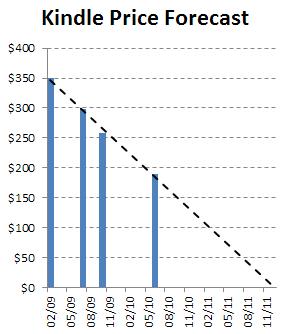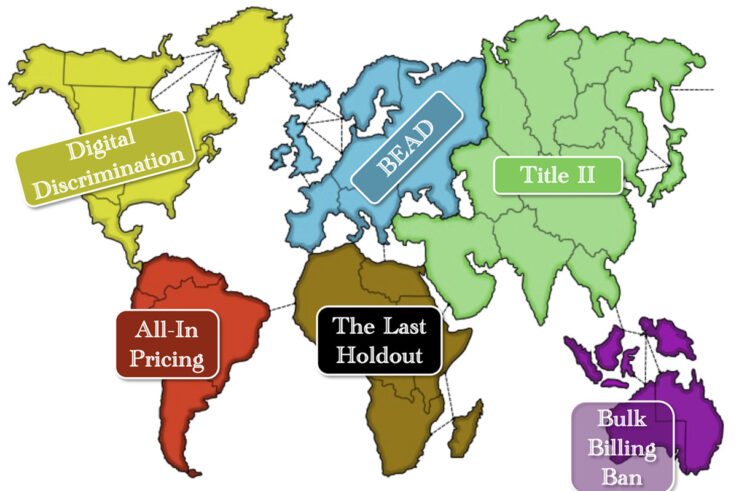[UPDATE: Josh links to a WSJ article telling us that EU antitrust enforcers raided several (unnamed) e-book publishers as part of an apparent antitrust investigation into the agency model and whether it is “improperly restrictive.” Whatever that means. Key grafs:
At issue for antitrust regulators is whether agency models are improperly restrictive. Europe, in particular, has strong anticollusion laws that limit the extent to which companies can agree on the prices consumers will eventually be charged.
Amazon, in particular, has vociferously opposed the agency practice, saying it would like to set prices as it sees fit. Publishers, by contrast, resist the notion of online retailers’ deep discounting.
It is unclear whether the animating question is whether the publishers might have agreed to a particular pricing model, or to particular prices within that model. As a legal matter that distinction probably doesn’t matter at all; as an economic matter it would seem to be more complicated–to be explored further another day . . . .]
A year ago I wrote about the economics of the e-book publishing market in the context of the dispute between Amazon and some publishers (notably Macmillan) over pricing. At the time I suggested a few things about how the future might pan out (never a god good idea . . . ):
And that’s really the twist. Amazon is not ready to be a platform in this business. The economic conditions are not yet right and it is clearly making a lot of money selling physical books directly to its users. The Kindle is not ubiquitous and demand for electronic versions of books is not very significant–and thus Amazon does not want to take on the full platform development and distribution risk. Where seller control over price usually entails a distribution of inventory risk away from suppliers and toward sellers, supplier control over price correspondingly distributes platform development risk toward sellers. Under the old system Amazon was able to encourage the distribution of the platform (the Kindle) through loss-leader pricing on e-books, ensuring that publishers shared somewhat in the costs of platform distribution (from selling correspondingly fewer physical books) and allowing Amazon to subsidize Kindle sales in a way that helped to encourage consumer familiarity with e-books. Under the new system it does not have that ability and can only subsidize Kindle use by reducing the price of Kindles–which impedes Amazon from engaging in effective price discrimination for the Kindle, does not tie the subsidy to increased use, and will make widespread distribution of the device more expensive and more risky for Amazon.
This “agency model,” if you recall, is one where, essentially, publishers, rather than Amazon, determine the price for electronic versions of their books sold via Amazon and pay Amazon a percentage. The problem from Amazon’s point of view, as I mention in the quote above, is that without the ability to control the price of the books it sells, Amazon is limited essentially to fiddling with the price of the reader–the platform–itself in order to encourage more participation on the reader side of the market. But I surmised (again in the quote above), that fiddling with the price of the platform would be far more blunt and potentially costly than controlling the price of the books themselves, mainly because the latter correlates almost perfectly with usage, and the former does not–and in the end Amazon may end up subsidizing lots of Kindle purchases from which it is then never able to recoup its losses because it accidentally subsidized lots of Kindle purchases by people who had no interest in actually using the devices very much (either because they’re sticking with paper or because Apple has leapfrogged the competition).
It appears, nevertheless, that Amazon has indeed been pursuing this pricing strategy. According to this post from Kevin Kelly,
In October 2009 John Walkenbach noticed that the price of the Kindle was falling at a consistent rate, lowering almost on a schedule. By June 2010, the rate was so unwavering that he could easily forecast the date at which the Kindle would be free: November 2011.
There’s even a nice graph to go along with it:

So what about the recoupment risk? Here’s my new theory: Amazon, having already begun offering free streaming videos for Prime customers, will also begin offering heavily-discounted Kindles and even e-book subsidies–but will also begin rescinding its shipping subsidy and otherwise make the purchase of dead tree books relatively more costly (including by maintaining less inventory–another way to recoup). It will still face a substantial threat from competing platforms like the iPad but Amazon is at least in a position to affect a good deal of consumer demand for Kindle’s dead tree competitors.
For a take on what’s at stake (here relating to newspapers rather than books, but I’m sure the dynamic is similar), this tidbit linked from one of the comments to Kevin Kelly’s post is eye-opening:
If newspapers switched over to being all online, the cost base would be instantly and permanently transformed. The OECD report puts the cost of printing a typical paper at 28 per cent and the cost of sales and distribution at 24 per cent: so the physical being of the paper absorbs 52 per cent of all costs. (Administration costs another 8 per cent and advertising another 16.) That figure may well be conservative. A persuasive looking analysis in the Business Insider put the cost of printing and distributing the New York Times at $644 million, and then added this: ‘a source with knowledge of the real numbers tells us we’re so low in our estimate of the Times’s printing costs that we’re not even in the ballpark.’ Taking the lower figure, that means that New York Times, if it stopped printing a physical edition of the paper, could afford to give every subscriber a free Kindle. Not the bog-standard Kindle, but the one with free global data access. And not just one Kindle, but four Kindles. And not just once, but every year. And that’s using the low estimate for the costs of printing.




